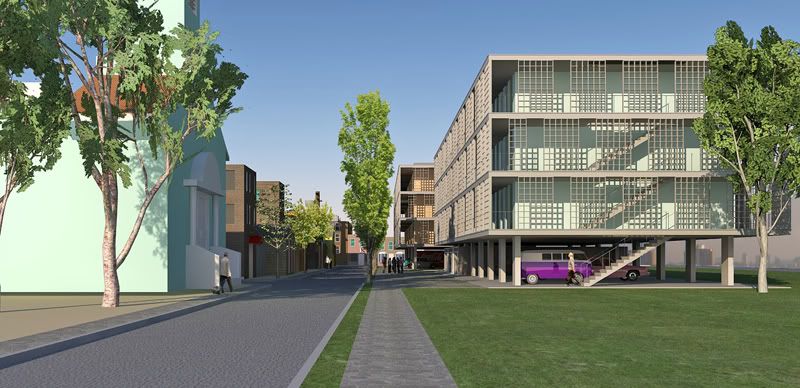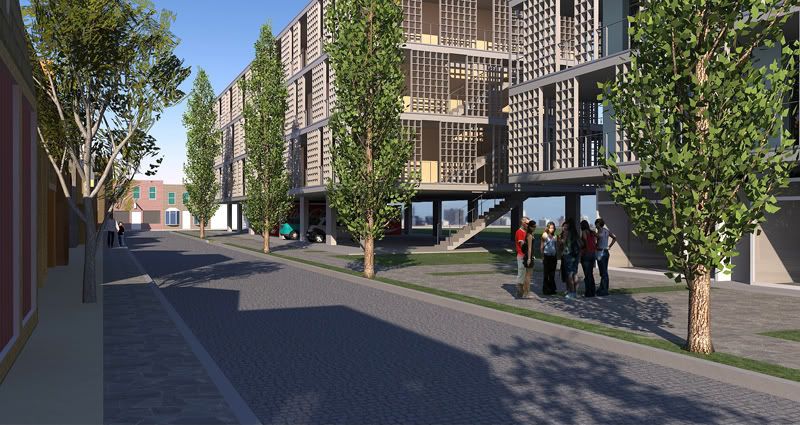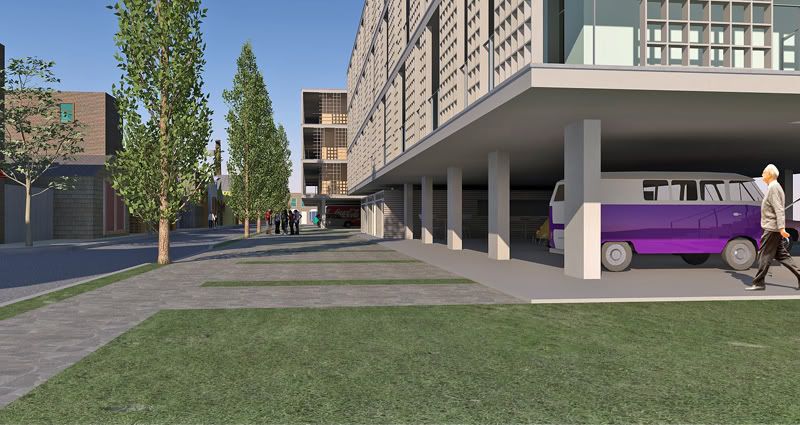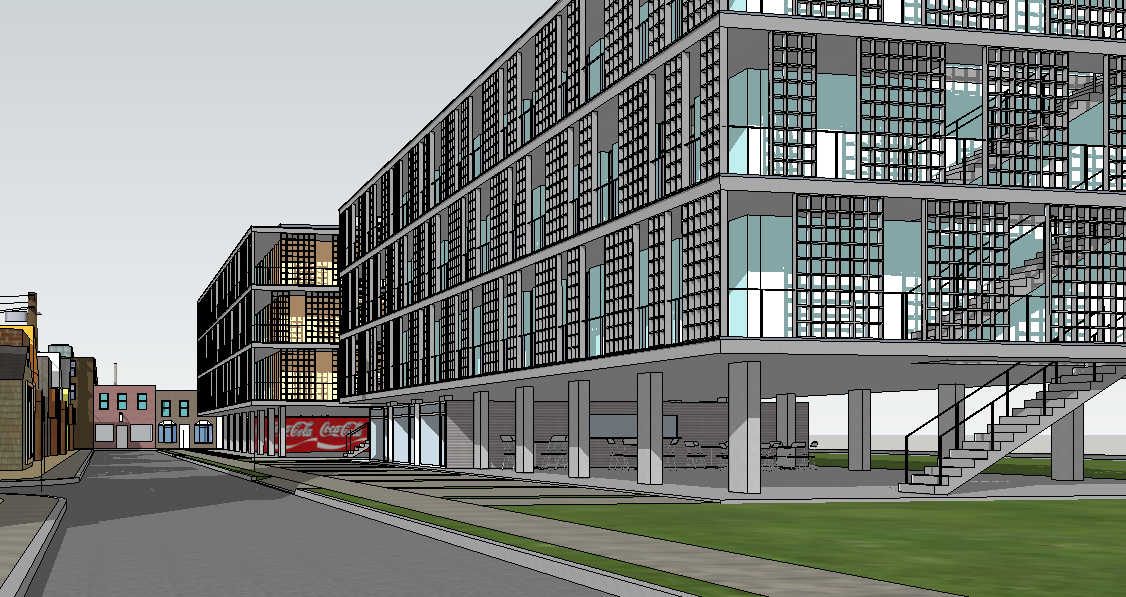Social Housing in Brasil (Podium renders)
-
after a while without posting any work, here are some images from a social housing scheme I developed for a slum in curitiba.




-
... I see you've solved the tree problem

The scheme looks nice (from visuals only),
but it seams to me that it lacks some ground level activities - shops, restaurants...itc
for making it lively and secure. -
@srx said:
... I see you've solved the tree problem

The scheme looks nice (from visuals only),
but it seams to me that it lacks some ground level activities - shops, restaurants...itc
for making it lively and secure.hi srx,
have a look at the image below and you will see that I planned exactly what you are suggesting: the ground plan is reserved for services, shops, any kind of activity of a collective nature. the actual definition of what would be put there was left to be decided with the residents; they may even decide to set some area apart for parking.
I imagined those spaces would be done in light construction so that they could be easily changed over time. in the image, there are some shops made of steel structure and closed with steel corrugated sheets.
cheers.

-
Lovely!
-
Edson
That's a real fine idea to have the "parking space" decide on by the community. Projects like this, if successful get real community buy in which can lead to a pride which quite often brings vandalism, and crime way down.
There is an Architect in Portland Oregon, Mark Lakeman who has been working very successfully with this concept for the past years.
Very nice work. -
In this case, I like the SU only image over the rendered ones, not sure why. The narrow easement planting strip is a small problem for me, and the 2.5D tree in the top image foreground is a distraction. I like the building skyline in the background under the building, and I see that we share similar people:-)
-
I thank you all for your comments.
@honolulu,
yes, I am not too happy about the left foreground tree either. it was put there to prevent the church from dominating the foreground, but its something that can be improved.as I understand it, you mentioned the narrow strip between the curb and the sidewalk, right? in many places in brasil you are bound to do that by law.
-
Good concept! I think it deserves to be more obvious from visuals. (Looking in the shops, people going in out itc.)
-
@srx said:
Good concept! I think it deserves to be more obvious from visuals. (Looking in the shops, people going in out itc.)
yes, I agree. these first renders had more to do with getting a grip on podium V2 than explaining all the aspects of the project. the next ones will try to do what you suggest. thanks.
-
Hi Edson,
I just want to ask about the Podium 2 improvements. Don't have much experience with Podium except for trialing the previous version.
Maybe I should just trial the latest!
Really nice scene too!
-
@unknownuser said:
Hi Edson,
I just want to ask about the Podium 2 improvements. Don't have much experience with Podium except for trialing the previous version.
Maybe I should just trial the latest!
Really nice scene too!
hi rich,
if you ask me I will tell you to try V2, by all means. I have used V1.7 for about two years and see much improvement in V2 (it has a brand new rendering engine). to me the most noticeable improvements are:- it is much faster;
- interior views get much better lighting from sunlight;
- exterior views do not demand as much post-processing as before;
- material handling is much easier (you assigning attributes to the material, not to the individual element);
- artificial lighting got much easier.
in sum, it is well worth a try.
-
Edson.
I'm really sorry, don't take this the wrong way, but I'm not a fan of this design. It looks far too much like a parking lot to me, and I especially don't like the parking/ social area underneath. Can you imagine gangs of youths using it for parties late at night? The low ceiling would cause a reverberation effect, amplifying their voices, making it nigh impossible for anyone upstairs to get any sleep. And what happens if someone drives, at high speed into one of the supporting pillars? I think I would feel very nervous living upstairs.
To be honest, I've never really been a fan of 'social housing' projects anyway. Tony Benn made a big mess of this country with his flat building schemes. Most became ghetto'ised, and imprisoned many of the more frail and elderly people living in them in later life. Developers who have built new flats in inner Birmingham city, hoping to make a profit during the housing boom of the last decade, are now having major problems selling them on. They are actually largely empty (all over the country in fact). People want houses with gardens and their own parking spaces, not flats.
-
Edson
Mate I like the images but that alone is not showing the solution which is more about the solutions of private access, security, private open space, privacy etc.
From the images I'm envisaging all units are accessed from the long balcony that runs around the perimeter, for me this actually creates more issues in this type of housing than it solves. This is somewhat further exaggerated by the stair access direct to ground level with no arrival / entry sequence. For me these few simple factors are tending to replicate issues that exist now in this style of development.
-
To tfdesign and Richard - this is in Brasil, different social context
-
@srx said:
To tfdesign and Richard - this is in Brasil, different social context
Sorry srx, Brazil or elsewhere, the context is the same. We are all human beings!


-
Disagree. If it is the same then there would be no difference between houses around the World...People live different - houses are different.
The one obvious thing - amount of $! -
Sure I understand that provincial factors most often drive designs. That said I still think some general principles if considered can enact a break from the norn, that is in part the beauty of the global community. Ideas can cross boundaries.
As this is designed as infill within a slum, is it wise to replicate what first created it?
-
@richard said:
As this is designed as infill within a slum, is it wise to replicate what first created it?
Quite right.
The British social housing experiment has been a disaster. In some cases it has also created housing estates where people are afraid to venture. In Britain we are only beginning to understand the main causes, except now it has become very difficult to change because we too lack the funds to build better housing. I agree that much is to do with capital, but there, I wholeheartedly agree with Richard's point above. Look at the west, look a Britain, once one of the richest countries in the world- now has one of the largest western poor/rich divides (for Europe).
Flats are a developer's 'dream' (cheap, easy to construct, and you can stack them high- but only if developers can then sell them), but are curse on the people who buy them, and eventually get caught there, because no one really wants to live stacked on top of one another. They are even worse if they have been built by a council to aid 'social development'
A really good film worth watching (and which really highlights this 'social housing is good' myth) is the Sicilian/ Italian film "Gomorrah".
http://en.wikipedia.org/wiki/Gomorrah_(film
Tom
-
tfdesign and richard,
I often regret posting renders here as people tend to focus on the little piece of design they see and not on the renders.
of course, people are entitled to dislike what one posts here. I just wish they would base their opinions on a sounder foundation, to use an architectural metaphor.
I can only agree with srx: brasil is not australia or the UK. in fact, they are worlds apart. unless you have spent some time in brasil, and more particularly in that community, you are talking about a local context of which you have no knowledge. perhaps social housing here is not the same as in the UK, nor are the local youth similar their british counterparts in terms of behaviour. have you thought of that?
yes, we are all human beings, no matter where we come from. however, there are huge cultural differences between brazilians, aussies and britons.
that particular community is a close knit one. the main problem there is the fact that many houses were irregularly built too close to a stream, with obviously bad consequences for the immediate areas. the people there accept to have their houses removed from the stream banks but do not want to be moved to a distant location, as is the usual practice. the equation is like that: if people want to stay there and the area will be reduced by the removal of the houses on the stream the only way to build is up: thus the three story buildings.
observation of their living habits showed that there are small shops interspersed between the houses, the houses always have a parking space, and the space immediately in front of their houses is used as a place for sitting outside and socializing. thus the proposed buildings have a flexible ground floor that could absorb all those uses and whose actual occupation will be decided in agreement with the residents. thus the access balcony, wide enough for them to use for more than circulation. thus the absence of an arrival/entry sequence. they do not see a need for that as today their front doors face directly onto the street and they do not wish to change that.
as you can easily see, matters are not as simple as they appear. applying 1st world standards to a situation like that will simply not work.
-
@edson said:
perhaps social housing here is not the same as in the UK, nor are the local youth similar their british counterparts in terms of behaviour. have you thought of that?
Of course I have (thought of that).
But in my experience, it is poverty that causes corruption as well as powers that stay in place for years on end. South America is a third world region, but putting people in badly designed housing is a problem which is universal right across the globe. Just because you are in Brazil, it doesn't make much of a difference.
I commented on the design, because I thought it was right to discuss design on a design forum! If we can't make constructive criticism, then what is the point in having an open forum? After all, the very word "Forum" is latin for "a large meeting square at the middle of a city", where perhaps people meet to share ideas.
regards,
Tom
Advertisement







